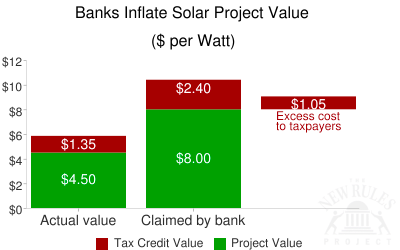This post originally appeared on Energy Self-Reliant States, a resource of the Institute for Local Self-Reliance’s New Rules Project.
 Solar leasing has offered thousands of homeowners a “no money down” route to go solar, broadening participation in the distributed generation revolution. Unfortunately, this revolution has been co-opted by high finance. Big banks have been able to write off millions in taxes by overreporting the cost of financed solar PV projects in what may be the country’s next banking scandal.
Solar leasing has offered thousands of homeowners a “no money down” route to go solar, broadening participation in the distributed generation revolution. Unfortunately, this revolution has been co-opted by high finance. Big banks have been able to write off millions in taxes by overreporting the cost of financed solar PV projects in what may be the country’s next banking scandal.
In a phone conversation last month, Jigar Shah of Carbon War Room (formerly chief of solar-as-a-service company SunEdison) disclosed that while solar leasing companies can install residential solar for between $4.00 and $5.00 per watt, they routinely claim federal tax credits on the “fair market value,” a price nearly twice as high. A solar tax lawyer confirmed this practice and that it also applies to the program providing cash grants in lieu of the federal Investment Tax Credit. “The equipment may be financed in a way that allows the solar company to calculate Treasury cash grants on the fair market value of the systems rather than their cost,” he wrote to me this week.
The practice boosts banks’ bottomline at the expense of federal taxpayers and unnecessarily increases the cost of public subsidies for renewable energy.
In California, for example, 15 percent of small-scale PV projects completed in 2010 were “third party owned” — code words for a solar leasing arrangement. If banks used “fair market value” rather than the actual system cost for the tax credits on those systems, the inflated tax credits could have totaled as much as $30 million instead of the $18 million justified by the actual project costs.
That’s just the tip of the iceberg. This $12 million difference only reflects about one-third of the U.S. residential solar PV market. In other words, the over-payment to banks financing solar leasing could be as much as $36 million in 2010 alone. It’s no wonder U.S. Bank just announced a new commitment to finance $200 million of residential solar PV.
The problem isn’t unknown to the federal government. The solar tax lawyer I spoke to noted that “Treasury has been pushing back on some fair market value claims as too high.”
Treasury should push a little harder. Why should big banks get a bigger tax credit for the same size solar PV array than a homeowner?
The lone bright spot is that the growth in solar leasing has slowed somewhat in the past two years. Previously, solar leasing may have been the only way for some individuals to capture the federal solar tax credits, if they didn’t have enough tax liability. As an alternative, big banks would provide up-front financing in exchange for the tax credits (and the opportunity to inflate their value). We’ve previously discussed why tax credits make for lousy renewable energy policy. In 2009 and 2010, however, changes to the federal tax credits allowed people to take a cash grant instead, reducing the need for third party ownership. That ends in December.
Long before that, Treasury should shut down the practice of overestimating project costs with “fair market value.” Solar energy incentives have built the American solar market and helped drive down the cost of solar. Banks shouldn’t be allowed to subvert these public incentives.



